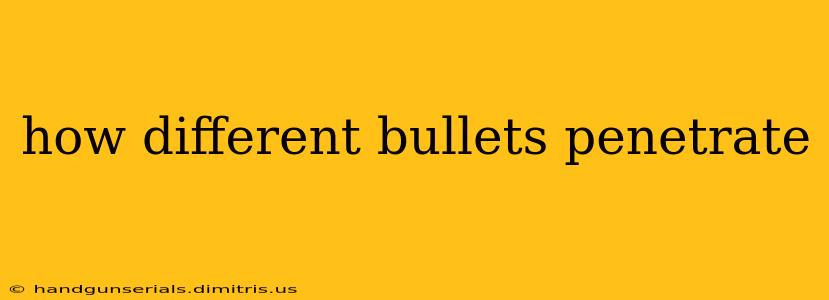Understanding how different bullets penetrate targets is crucial for a variety of fields, from law enforcement and military applications to hunting and firearms safety. This comprehensive guide explores the factors influencing bullet penetration, examining the characteristics of various bullet types and their effects on different materials.
Factors Affecting Bullet Penetration
Before delving into specific bullet types, it's essential to understand the key factors that dictate penetration depth:
-
Caliber: Larger caliber bullets generally have greater mass and energy, leading to increased penetration. However, other factors often outweigh this simple relationship.
-
Bullet Construction: The material and design of the bullet significantly impact its penetration. Full metal jacket (FMJ) bullets, for instance, tend to penetrate deeper than hollow point (HP) rounds due to their superior structural integrity.
-
Velocity: Higher velocity translates to greater kinetic energy, resulting in deeper penetration. This is a critical factor, often overshadowing caliber differences.
-
Shape: The bullet's shape, particularly its nose design, plays a role in its ability to penetrate. A pointed or boat-tail design minimizes drag and maximizes penetration, while a flat-nosed bullet may transfer more energy to the target, causing more immediate damage but potentially less penetration.
-
Target Material: The density and composition of the target material heavily influence penetration depth. Hard materials like steel offer significantly more resistance than softer materials like flesh or wood.
-
Twist Rate: The rifling in a firearm's barrel imparts spin to the bullet, which stabilizes its flight and improves accuracy. However, the twist rate can indirectly influence penetration by affecting the bullet's stability and its ability to maintain its trajectory.
Common Bullet Types and Their Penetration Characteristics
Let's examine how different bullet types penetrate:
1. Full Metal Jacket (FMJ) Bullets:
- Construction: A lead core encased in a gilding metal jacket.
- Penetration: High penetration due to their structural integrity and streamlined design. They often pass through targets without significant expansion or fragmentation.
- Applications: Commonly used in military and law enforcement applications, where penetration is prioritized over immediate incapacitation.
2. Hollow Point (HP) Bullets:
- Construction: A lead core with a hollow cavity at the tip.
- Penetration: Moderate penetration. Upon impact, the hollow point expands and flattens, transferring more energy to the target and causing greater tissue damage. Reduced penetration is a trade-off for increased stopping power.
- Applications: Primarily used for hunting and self-defense, where stopping power is critical.
3. Jacketed Hollow Point (JHP) Bullets:
- Construction: Similar to HP bullets, but with a gilding metal jacket covering the lead core.
- Penetration: A balance between penetration and expansion; offers better controlled expansion compared to standard HP bullets.
- Applications: Popular choice for self-defense and hunting due to their reliable expansion and controlled penetration.
4. Soft Point (SP) Bullets:
- Construction: A lead core with a partially exposed lead tip.
- Penetration: Moderate penetration with increased expansion compared to FMJ bullets.
- Applications: Frequently used in hunting, particularly for larger game.
5. Armor-Piercing Bullets:
- Construction: Designed to penetrate armor plating, typically with a hardened steel core.
- Penetration: Extremely high penetration, capable of piercing body armor and other hard targets.
- Applications: Military and law enforcement applications where penetration of protective gear is necessary. Strict regulations govern their civilian use.
Conclusion
The penetration of a bullet is a complex interaction between the bullet's characteristics, its velocity, and the properties of the target. This overview provides a general understanding of how different bullet types behave; however, specific penetration depths can vary significantly based on the factors discussed above. Always consult reliable sources and professional guidance when handling firearms or dealing with ballistics-related topics. Safety should always be the paramount concern.

